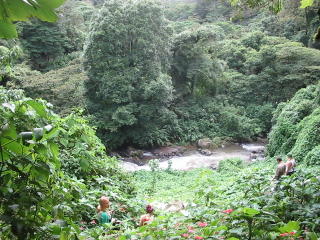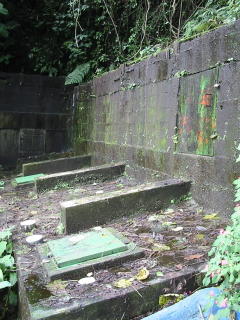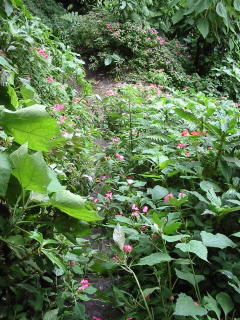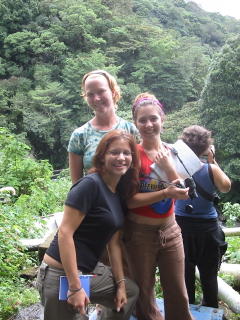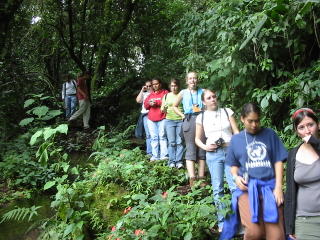Different Realities...
Hello all, I am back from a refreshing weekend away in Monteverde. The purpose of my trip was both academic and for pleasure. What relief fresh mountain air can be! I was in a bit of a bad mood at the end of last week, despite the fact that I have been re-affirming positive mantras daily, and felt a huge weight lifted as soon as I stepped off of the bus and took a deep breath. Brittany and I decided to stay at an affordable family-run place called Cabinas Don Taco, which offered a view of the Nicoya Peninsula and an electrical outlet on the large porch, so that we could work oon our computers and enjoy the natural environment at the same time.
We arrived on Friday night, and I immediately started calling people for appointments for the next day. Monteverde is an interesting place, as there is a huge permanent population of extranjeros [foreigners]. I have been interviewing poor Nicaraguan immigrants in San Jose, and wanted to contrast this with the documentation of immigrant experiences form the entire opposite end of the spectrum. This weekend I met with people from Argentina, USA, Israel, Austria and Canada. Although they all had different reasons for moving, one element was common, all came out of desire not out of necessity. Here they are able to create a more intentional and idyllic life, as opposed to the Nicaraguans I have interviewed who have come out of necessity, to keep their children from starving, and still live in slum, urban areas. The people in Monteverde all had the resources to move, whereas the Nicaraguans don't have the resources NOT to move {if that makes any sense}. It is an interesting comparison of needs versus wants, or even the relative perception of needs to one's previous life experiences. For people in Monteverde it was a need to live in a tranquil place, close to wildlife and a vibrant natural environment. For the Nicaraguans in San Jose, and all over Nicaragua it is a need to simply meet basic needs and continue surviving, however they are able.
We arrived on Friday night, and I immediately started calling people for appointments for the next day. Monteverde is an interesting place, as there is a huge permanent population of extranjeros [foreigners]. I have been interviewing poor Nicaraguan immigrants in San Jose, and wanted to contrast this with the documentation of immigrant experiences form the entire opposite end of the spectrum. This weekend I met with people from Argentina, USA, Israel, Austria and Canada. Although they all had different reasons for moving, one element was common, all came out of desire not out of necessity. Here they are able to create a more intentional and idyllic life, as opposed to the Nicaraguans I have interviewed who have come out of necessity, to keep their children from starving, and still live in slum, urban areas. The people in Monteverde all had the resources to move, whereas the Nicaraguans don't have the resources NOT to move {if that makes any sense}. It is an interesting comparison of needs versus wants, or even the relative perception of needs to one's previous life experiences. For people in Monteverde it was a need to live in a tranquil place, close to wildlife and a vibrant natural environment. For the Nicaraguans in San Jose, and all over Nicaragua it is a need to simply meet basic needs and continue surviving, however they are able.
